Table of Contents
Introduction: Why Manufacturing B2B Companies Can’t Ignore E-commerce in 2025
E-commerce represents a critical competitive advantage for manufacturing B2B companies looking to serve customers and sell in entirely new ways. However, the traditional B2C approach to e-commerce can be counterproductive for B2B manufacturers.
E-commerce in the B2B manufacturing sector should be viewed as digital sales enablement rather than simple transactions. Buyers now expect to research products, configure solutions, obtain pricing, and often complete purchases entirely online – mirroring the seamless experiences they’ve grown accustomed to in their personal lives.
Millennials now make up 73% of B2B buyers, bringing expectations shaped by consumer digital experiences. Gartner predicts that 80% of B2B sales interactions will occur in digital channels by 2025, driven by buyer preferences for self-service and hybrid engagement.
The paradigm has shifted: previously, a website supported a salesperson; now, a salesperson enhances the digital experience. Both remain essential, but the emphasis has fundamentally changed.
This guide outlines how manufacturing B2B companies can leverage digital sales channels and what to consider when making these critical investments in 2025 and beyond.
The Reality: Complex Manufacturing Products Can Be Sold Online
Online spare parts sales are already commonplace for many manufacturers. However, selling core products – whether industrial equipment, machinery, or complex systems – presents unique challenges that many companies believe are insurmountable.
Common misconceptions persist:
- “Our products are too complex for self-service”
- “Customers need extensive technical consultation”
- “Configuration requires expert knowledge”
The reality is different. B2B buyers in 2025 demand greater control over their purchasing journeys, from transparent pricing models to algorithm transparency, and they expect faster, more personalized experiences at every touchpoint.
The Customer-Centric Approach to Complexity
Here’s a typical conversation we have with manufacturing sales teams:
Sales Team: “Customers don’t understand product specifications well enough to choose correctly.”
Our Response: “Exactly – they shouldn’t need to be product experts. How do you, as specialists, determine the right solution?”
Sales Team: “We ask about their application, operating conditions, and requirements. Based on those answers, we recommend the appropriate solution.”
Our Response: “Those questions can be structured into a guided digital experience that leads customers to the right products automatically.”
This example illustrates the shift needed: instead of expecting customers to master your technical specifications, create digital tools that translate their needs into proper solutions.
The key principle: Customers need to describe their problem, not engineer your solution.
Why is Now a Good Time for Manufacturing Company to Invest in B2B E-commerce?
1. E-commerce Technologies Have Evolved to Meet the Needs of B2B Manufacturing Companies
Previously, the market was dominated by e-commerce technology designed primarily for consumer sales. The systems excelled at managing hundreds of thousands of articles, but heavy integrations, high project costs, and significant restrictions on sales models often posed problems for B2B companies.
One client described the situation:
“E-commerce projects are like Pandora’s box. Once opened, numerous large and unpleasant projects emerge that need to be addressed concurrently if you want to complete the e-commerce implementation. The result is gray hair and a budget overrun by several multiples.”
Modern e-commerce technology adapts to the needs of B2B companies, making it significantly faster and easier to start selling online than before.
One of the biggest recent advances in B2B e-commerce is the support for new sales models. This means that a suitable sales model can be chosen for each need: some products as self-service, others through quotation requests, and some allowing the customer to configure the desired product, see a price estimate, and easily make a quotation request.
In the past, some companies built registration-required portals instead of online stores, if showing prices publicly wasn’t sensible or possible due to fierce price competition. These portals often failed to meet customer expectations for usability and consumer-like experiences. Compromises are no longer necessary.
2. Configurators Benefit Customers, Not Just Sellers
Some manufacturers of machinery and equipment have already adopted custom-built configurators that allow customers to specify the features of the product they’re ordering.
The problem with these solutions often is that they’re designed not with the customer in mind but to facilitate sellers’ quotation calculations, leading to overly complex interfaces, difficult questions, and simply too many options. It goes without saying this leaves customers frustrated with bad customer experience.
The result might be a solution that doesn’t fit the customer’s needs or becomes very expensive to develop and maintain. Often, these configurators have fallen into the common pitfall of digitization: only updating the tools from analog to digital without rethinking how the whole process could be done better.
Pioneering companies, such as Tesla, have taken a different approach by building configurators with the end-user in mind. We have written about Tesla’s digital first sales approach and what B2B companies could learn from Tesla on this post.
When using a configurator, the customer doesn’t need to know every technical detail, part numbers, or compatibility. Instead, they can choose desired functionalities, features, or express what they want to achieve.
If 90% of orders are made with 15 different combinations, there’s no need to offer all 1,300 combinations in the configurator. This makes the product configurator both easier to use and more useful. This doesn’t mean you can’t serve the remaining 10% of the potential customers – you just simply offer them a human touch to meet their needs.
Today’s modern, Visual CPQ software (visual product configurators) are extremely user-friendly and cost only a fraction of what the market has come to expect. An embedded configurator on the site serves interested customers 24/7/365, regardless of their continent.
3. E-commerce Opens Up Opportunities for New Business Models
Traditionally, many manufacturing companies have relied on their distributors to sell their products around the world as efficiently as possible.
At the same time, companies have given up a large portion of customer data and understanding to their distributors. This raises the question of who truly owns the customers: the distributor or the brand that manufactures the products?
Modern technologies enable selling through both resellers and directly to the end customer. This shift away from a distributor-led model towards a DTC (direct-to-customer) model presents an exciting opportunity for manufacturing companies.
While it may not be sensible to completely dismantle the traditional model overnight, digital sales channels offer companies the ability to sell more efficiently while gathering significantly more customer understanding and market data.
This enables far better and more customer-centric product development, as well as more effective sales and service business.
For the same reasons, the adoption of configurators has been crucial for manufacturing companies: it has provided a way to gather firsthand information about demand, including leads, while allowing manufacturers to pass quotation requests or leads to dealers.
Different Models of Digital Sales
In this chapter, I will introduce the various ways manufacturing companies can sell through digital channels. The models are examined especially on two axes: the model’s potential for scalable growth and the required change compared to traditional sales methods.
It is important to remember that the change is not limited to just technical issues (product information, availability, etc.) but is largely, perhaps mostly, about changing behavior and culture. Even a perfect solution produces nothing if no one uses it.
Considering the extent of change is important so that the company can make an informed decision on which projects to promote at any given time.
Naturally, the models with the greatest potential also come with a higher risk and a broader need for change. Therefore, it is particularly important to assess the company’s maturity level in those cases. Often, it makes sense to keep a long-term goal in mind but to start with sufficiently moderate steps.
However, from this selection, every manufacturing B2B company can find models suitable for different business models and situations.
Price Calculators
A price calculator has the pricing logic of the product for sale defined in it and, as its name suggests, it helps the customer calculate the price for a product or service. The price of the product can be given as an exact amount or as an indicative price estimate.
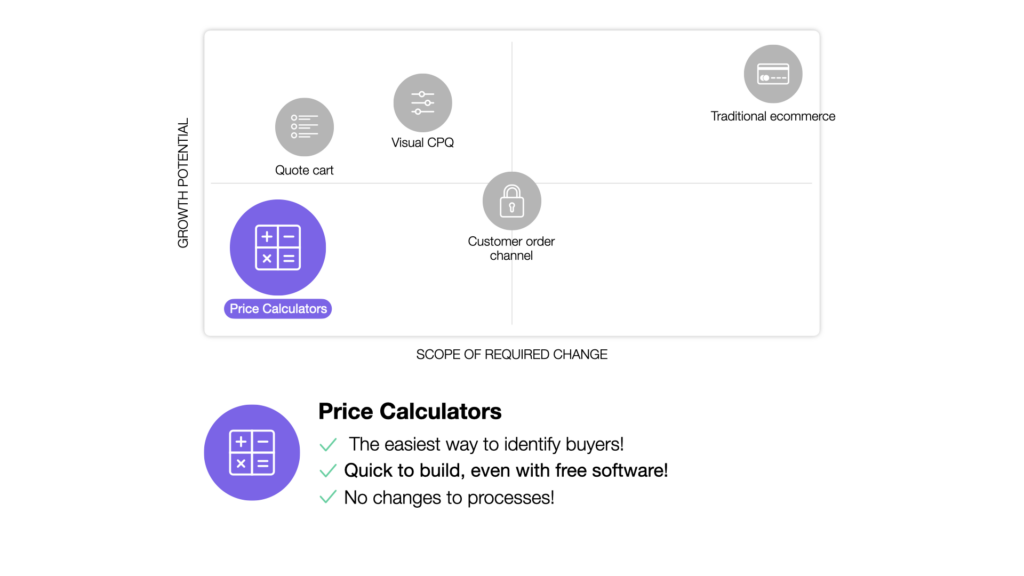
Why use price calculators?
1. For Customers: Fast and Easy Access to Pricing Information
A price calculator embedded on a website allows customers to quickly and effortlessly find out how much a product or service will cost. This enhances the user experience by providing immediate access to crucial information, which can significantly influence purchasing decisions.
2. For Businesses: Streamlines Sales and Generates Warm Leads
Especially for businesses that receive a high volume of pricing inquiries through various channels, price calculators can streamline the sales process.
By requiring customers to enter their contact information in exchange for a price estimate, businesses can collect warm leads. This process efficiently filters out serious inquiries from tire kickers.
Even if businesses choose not to require contact information for a price estimate, the information gathered from the interactions with the calculator allows for targeted advertising to a highly interested audience.
3. Acts as a Direct Sales Channel
After calculating the price, customers can be directed to make a purchase or request a binding offer. Thus, a price calculator can serve as an effective sales channel, simplifying the path to purchase and enabling a self-service option that today’s buyers increasingly prefer.
Who Can Benefit from Price Calculators?
Price calculators are versatile tools beneficial for a wide range of businesses:
Companies selling physical or digital products.
Service providers offering packaged services, such as accounting firms, occupational health services, law firms, property management companies, and media companies.
Virtually any company, regardless of how advanced or nascent its sales digitalization journey is, can benefit from implementing a price calculator. It’s particularly useful for businesses already receiving many price inquiries, as it offers an excellent starting point for online sales.
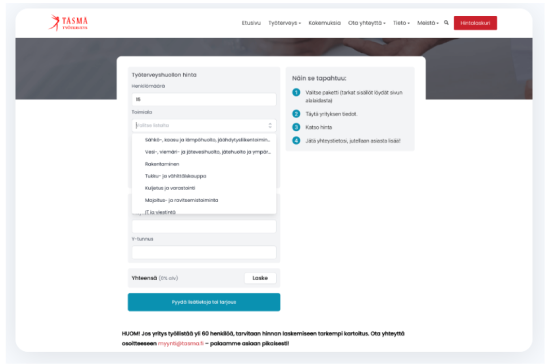
What does it cost?
Depending on their needs, businesses can opt for either an off-the-shelf solution or a fully customized build. An example of a ready-made solution is HeadQ, which offers both free and paid versions. The choice between a pre-built solution and a custom-developed one depends on the specific requirements, budget, and level of customization needed to align with the business’s offerings and customer interaction style.
In summary, incorporating a price calculator on your website can not only enhance customer experience by providing them with the pricing information they seek conveniently but also significantly improve your business’s lead generation and sales processes.
Quote cart
A quote cart offers customers a familiar online shopping experience but allows the business to avoid displaying its prices publicly or having to be fully prepared for direct e-commerce in terms of backend systems.
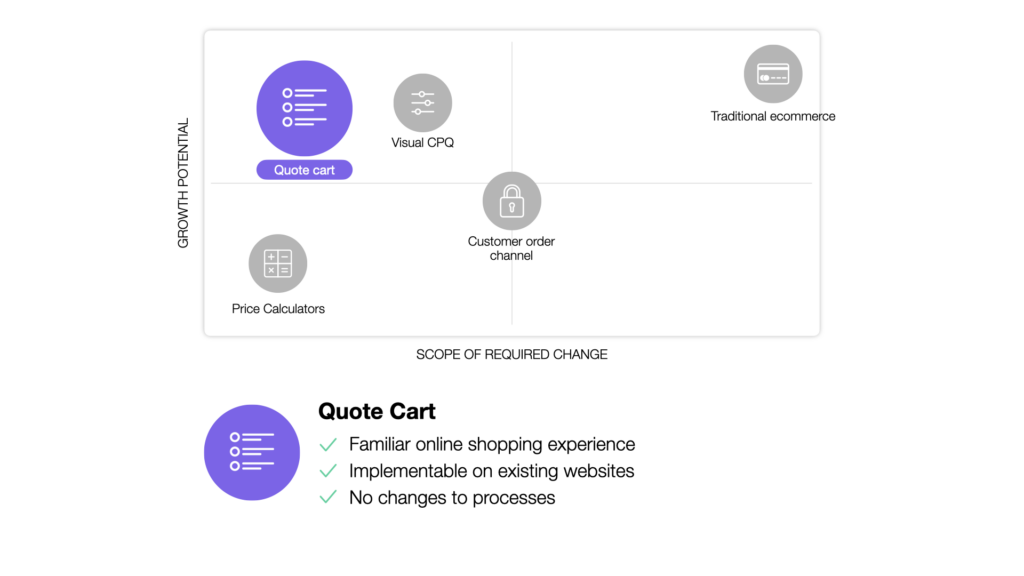
Why use a Quote cart?
Many B2B companies use quote carts on their websites because they make it easy to start online sales and save manual work for both sellers and buyers.
Instead of requesting a quote via a form, email, or phone – possibly for several different products – customers can add products to a quote cart. The ease of use can lead to increased sales: our customers using quote carts have reported that the average quote size has grown. See the Presto case study for an example.
Some technologies, like HeadQ, also streamline the following steps: with a few clicks, a seller can create a quote from the quote request, pricing the products as desired. The customer receives the quote in electronic form and can request changes or accept the quote and make a purchase.
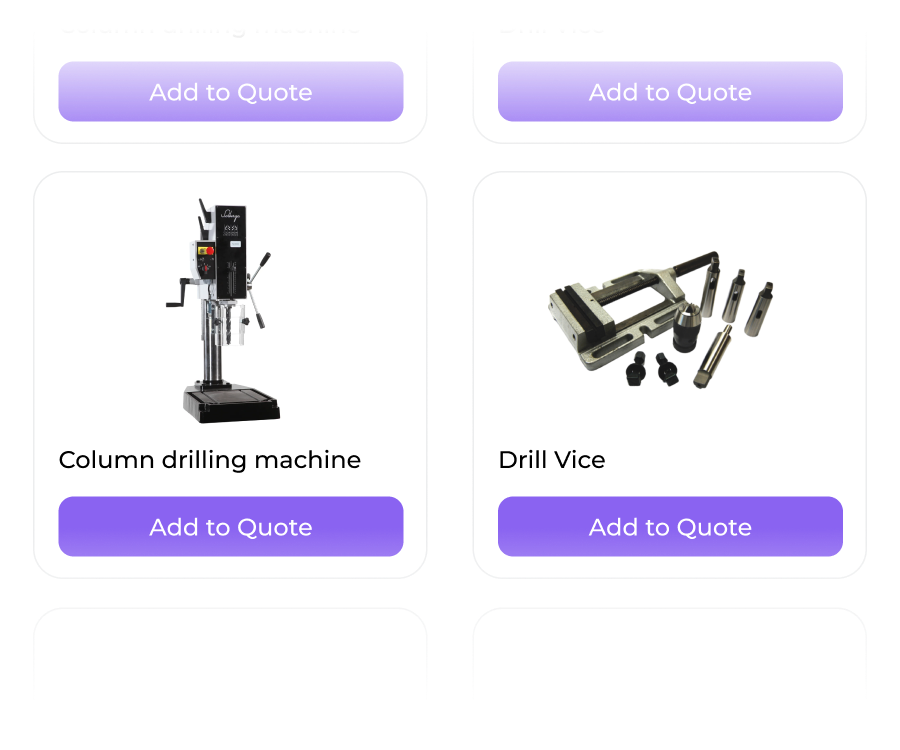
Who Are Quote Carts Suitable For?
Quote carts are an excellent tool for product companies with a large product range that receive many price inquiries.
Using a quote cart does not significantly alter existing sales processes but primarily makes it easier for customers to make purchases. Therefore, it is well-suited for many types of companies. Even many companies that have tried traditional online stores have ended up using quote carts, which better fit their operating methods.
Implementing a quote cart is easy, as it only requires the presentation of products on the company’s website. There are no other technical requirements, nor is there typically a need for integrations with backend systems. Thus, testing the functionality of a quote cart in customer use is straightforward.
What does it cost?
If a company has up to 100 products in its range, a free HeadQ quote cart is available. Packages with monthly fees are available for larger product numbers.
👉 Try Quote cart demo here
Visual CPQ (visual product configurators)
Using Visual CPQ software is an excellent way to sell complex products and services online. It allow customers to specify the desired features of a product and obtain an exact price or price estimate, either directly or through a quotation request.
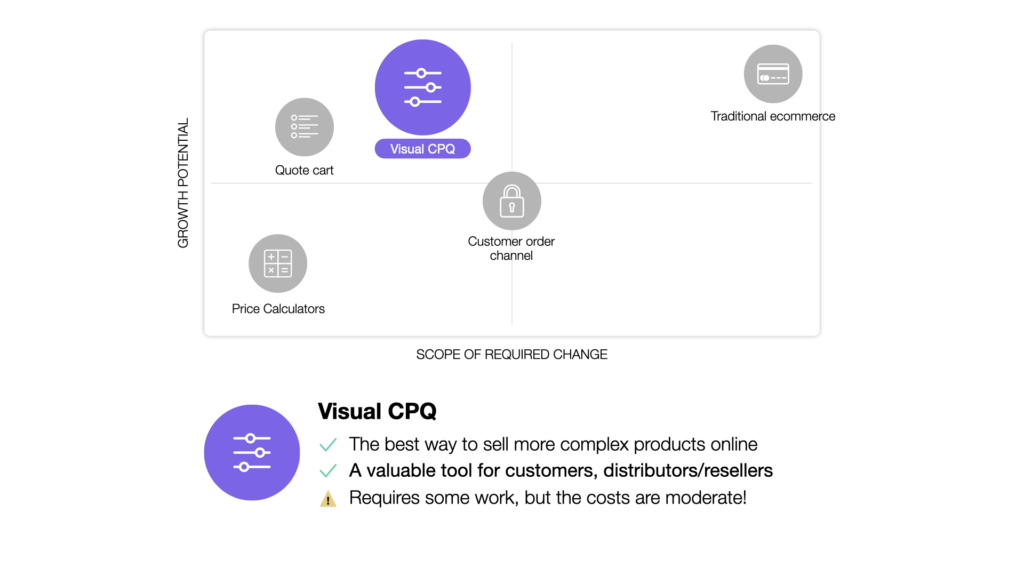
👉 Further reading:
✓ What is a product configurator
✓ Visual CPQ for Manufacturing companies
Why use Visual CPQ
Visual CPQ facilitate the buying process by enabling customers to explore products and easily obtain pricing information.
When price information is provided in exchange for customer contact details, sales departments receive high-quality leads through product configurators. These leads are easily qualified based on the configured product, for either a self-service process or for sales team follow-up.
Product configurators also serve as valuable tools for marketing teams, who can easily assess the value of demand created for a particular product.
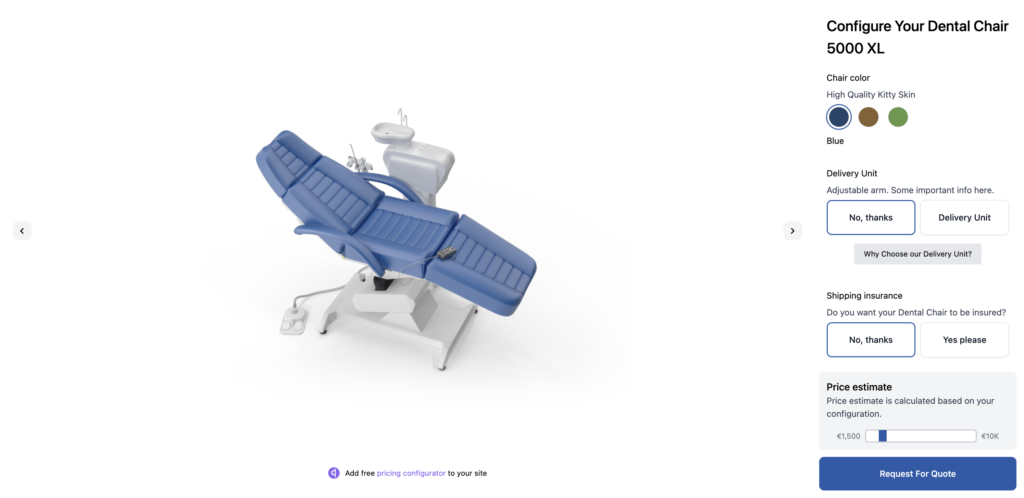
Who Should Use a Visual CPQ?
Visual CPQ is an excellent tool, especially for manufacturing companies and resellers wanting to offer their customers a seamless self-service experience as part of their sales process.
Many organizations also use product configurators at trade shows, where customers, guided by a salesperson, can explore products and various options. In this way, product configurators can become a collaborative tool between the customer and salesperson.
Visual product configurators naturally require that images of the configurable product are available. Typically, images derived from technical drawings (e.g., CAD files) are sufficiently effective.
If there is a desire to enable customers to purchase the configured product, it’s advisable to integrate the order information into a customer relationship management (CRM) or enterprise resource planning (ERP) system. Nowdays, this can be done relatively effortlessly.
What does it cost?
The formerly high costs associated with product configurators have become more moderate. HeadQ offers a free version as well as paid versions costing a few hundred euros per month.
👉 Try Visual CPQ demo here for free
Customer Ordering Channel
Online sales often start easily from existing customer ordering channels. Typically, these channels offer products most frequently purchased by the customer or the entire catalog, often with customer-specific pricing.
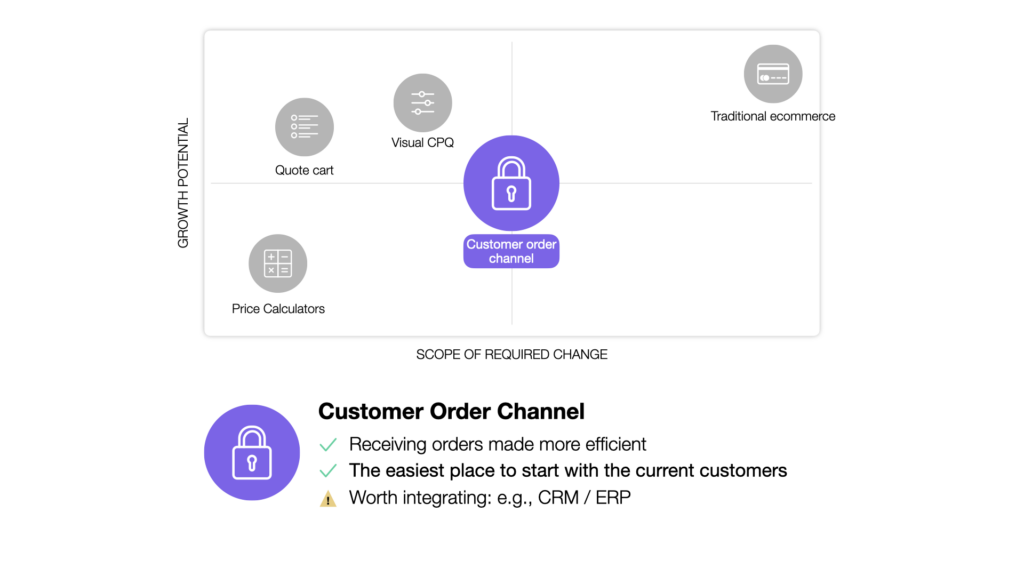
Why use Customer order channel?
1. Facilitates Customer Processes: A self-service channel makes it easier for customers to work and speeds up processes, which is typically desired by frequently purchasing customers. Responding positively to this request is advisable, as the risks of introducing a new sales channel are minimal due to the existing customer relationship and familiar operating methods.
2. Saves Work: Orders do not need to be taken manually, saving significant work. For customers, it offers the freedom to place orders whenever it suits them best, ensuring a modern purchasing experience.
3. Creates Competitive Advantage: A digital ordering channel provides a competitive edge and helps in customer retention, especially in highly competitive sectors. Many customers are hesitant to switch to a supplier that does not offer this facility.
Who is the Customer Ordering Channel Suitable For?
The customer ordering channel is particularly suitable for businesses with a significant number of customers and customer-specific pricing.
The business benefits of a customer ordering channel are most apparent in companies that already receive a substantial number of orders typically by phone or email. This includes product companies from which customers or resellers order multiple times a month.
Alternatively, a company can start increasing the number of self-service orders from scratch if developing digital sales over time and growing self-service purchases is crucial for the business.
To maximize benefits, integrating the ordering channel with systems like a CRM and an ERP system is recommended, so orders are processed automatically in the right place.
What does it cost?
There are solutions available that require an investment of a few hundred euros per month. HeadQ offers a free solution.
Traditional B2B ecommerce
Self-service, or “traditional B2B ecommerce,” refers to the solution that most closely resembles what has become standard in consumer e-commerce. Typically, there are a few differences in the process: invoicing is offered as a payment option, purchasing requires login, and customers may have their own, customer- or segment-specific pricing.
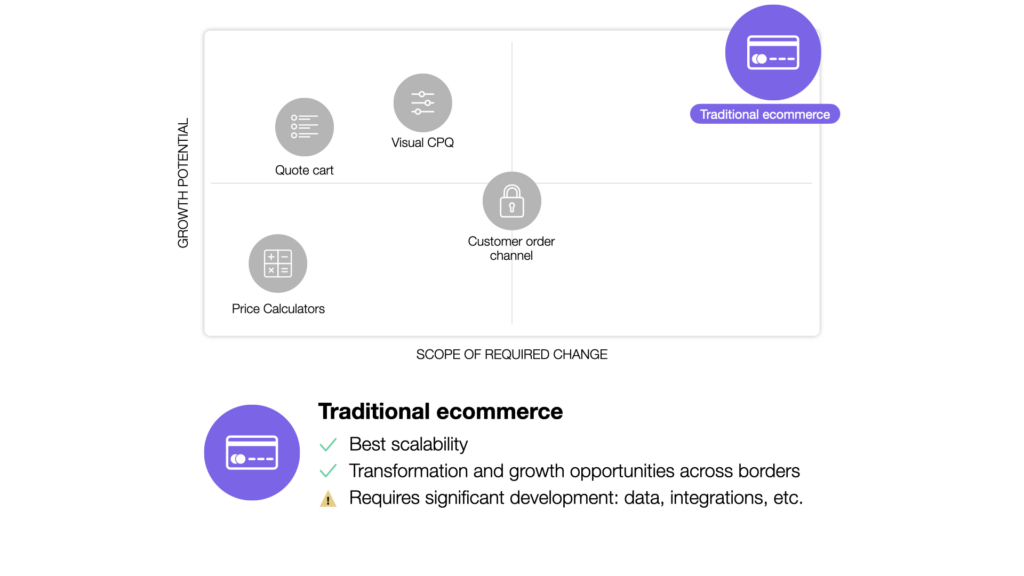
Why use traditional ecommerce?
The benefits of a self-service solution include ease of transaction for the customer and the ability to serve a wide customer base easily, cost-effectively, and at all times.
Who Is the Self-Service Solution Suitable For?
The self-service solution is particularly suited for product companies with a significant number of products. Many B2B companies use self-service solutions for selling spare parts, machinery, equipment and materials. The cost-effectiveness of a self-service solution becomes more pronounced as the volume of orders increases.
A self-service solution that fully benefits a company requires a lot from the company’s data and systems. Up-to-date availability information, comprehensive product details, and high-quality images are fundamental requirements.
A self-service solution has tremendous potential for scalable growth, but its suitability for a company’s business models and capabilities needs to be carefully assessed. It does not fit all situations as a replacement for personal service; other methods presented in this chapter might be a better investment in some cases.
What does it cost?
There are solutions available that require an investment of a few hundred euros per month. HeadQ offers a free solution.
How to get started in Developing Your Company’s Digital Sales
Approaching the development of your company’s digital sales as a process is advisable. For organizations accustomed to traditional sales methods, it may not be best to immediately embark on a large e-commerce project. Instead, consider first implementing a quote cart, price calculator, or product configurator.
This approach offers several benefits. Firstly, it allows you to quickly put digital sales into practice and start collecting data on customer behavior. This data is invaluable as you take the next step in development. At the same time, you’re managing the payback period for your investment and easing the management of internal change.
Throughout the journey, it’s important to keep in mind why you’re developing digital sales: it’s essential for ensuring your company’s competitiveness. Digital sales offer ways to meet customer expectations, streamline sales processes, and expand into new markets.
Transitioning to digital sales is an investment in your company’s future. We provide the best tools for it.
🤖 Explore this content with AI:
💬 ChatGPT 🔍 Perplexity 🤖 Claude 🔮 Google AI Mode 🐦 Grok
FREQUENTLY ASKED QUESTIONS
What does “digital sales” mean in manufacturing?
It’s not just “selling online.”
In manufacturing, digital sales means enabling your buyers to find, configure, and buy even complex products — machines, spare parts, or service packages — through your digital channels.
Each sale still involves specs, approvals, and customization. That’s why tools like a Product Finder or Visual CPQ exist: to make complex buying journeys smooth and self-service friendly.
Why do so many manufacturers struggle to start digital sales?
Because most eCommerce platforms were built for B2C, not for complex B2B sales.
HeadQ is built to solve manufacturing companies’ digital sales problems
How can we handle complex pricing and distributor agreements online?
Manufacturers rarely have one price list. Distributors, key accounts, and end customers all have their own rules. HeadQ solves this with Pricebooks — role-based pricing that reflects your real-world business logic.
How can digital sales and traditional sales teams work together?
Digital doesn’t replace sales reps — it equips them. When buyers use a Product Finder or Visual CPQ, reps instantly see what the buyer configured, which features matter, and what price range they saw. That turns every sales call into a continuation of the buyer’s journey, not a cold start.
What are the most common mistakes manufacturers make with eCommerce?
– Copying B2C models instead of building for their reality
– Launching too big, too fast instead of piloting one product line
– Neglecting onboarding for internal teams and customers
– Digital transformation fails when it’s treated as a one-time project. The winners treat it as an ongoing capability.
How should we measure results after launch?
Track both buyer behavior and internal efficiency:
– Time from inquiry → quote → order
– Share of leads coming from self-service tools
– Quote accuracy and margin consistency
– Distributor and rep adoption rate
Once you have baseline data, optimizing is easy — you’ll see exactly where your digital tools drive the biggest impact.